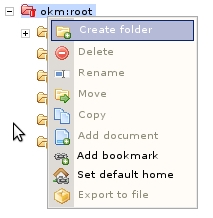Taxonomy
From OpenKM Documentation
Firstly, on the left of the desktop, is the Folder Tree or also called the Taxonomy. It displays a view of the repository distribution grouped by folders. There are various types of folders symbolised by the following icons:
-
 The folder has no more subfolders
The folder has no more subfolders -
 The folder contains subfolders
The folder contains subfolders -
 The folder is read-only and has no more subfolders
The folder is read-only and has no more subfolders -
 The folder is read-only and contains subfolders
The folder is read-only and contains subfolders -
 You are subscribed to the folder and it has no more subfolders
You are subscribed to the folder and it has no more subfolders -
 You are subscribed to the folder and it contains subfolders
You are subscribed to the folder and it contains subfolders -
 You are subscribed to the folder, it contains no subfolders and is read-only
You are subscribed to the folder, it contains no subfolders and is read-only -
 You are subscribed to the folder, it contains subfolders and is read-only
You are subscribed to the folder, it contains subfolders and is read-only
Basic functions with the mouse
- By clicking with the right mouse button a pop-up menu will appear. In this menu there are options to create new folders, delete, rename, etc.
- Drag & drop. By selecting a document or folder and keeping the left mouse button held permanently down, you can move a document or folder to a node of the tree (Taxonomy).
Pop-up menu
Description of the different options
-
 → Create a new folder
→ Create a new folder -
 → Delete folder.
→ Delete folder. -
 → Change the name of the selected folder.
→ Change the name of the selected folder. -
 → Change the localisation of the selected folder to another position on the tree, together with all the documents and folders it may contain
→ Change the localisation of the selected folder to another position on the tree, together with all the documents and folders it may contain -
 → Duplicate the folder and its contents in another place on the tree.
→ Duplicate the folder and its contents in another place on the tree. -
 → Add new document
→ Add new document -
 → Add a folder or document to the bookmarks
→ Add a folder or document to the bookmarks -
 → Set the folder or document as user home
→ Set the folder or document as user home -
 → Create a zip file with all the contents of the folder recursively, maintaining the folder structure.
→ Create a zip file with all the contents of the folder recursively, maintaining the folder structure.
